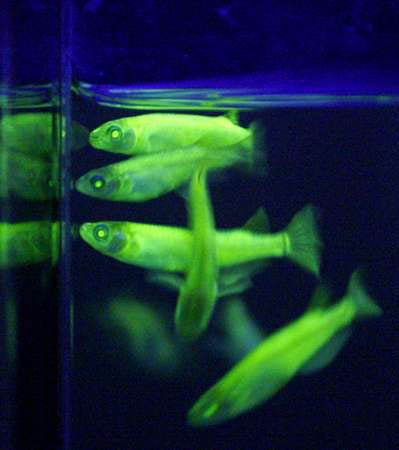 |
Green Fluorescent Fish to light up your home |
Ci-dessous un fichier odieusement détourné
(mais néanmoins authentique)
Adresse d'origine : http://www.dbs.nus.edu.sg/research/Fish%20bio/green_fluorescent_fish_to_light_.htm
 |
Green Fluorescent Fish to light up your home |
| Nous avions jusque là l'alevin, nous sommes en mesure de vous
montrer l'adulte !!
et c'est visible sur : http://www.wired.com/news/photo/0,1860,46678,00.html |
 |
| After three years, a research team at the National University
of Singapore led by Dr Gong Zhiyuan
from the Department of Biological Sciences has succeeded in cultivating
Zebra fish that radiate a greenish glow under special lighting. Soon, they
may also produce a fish that changes colour when it passes through different
temperatures, and glows with different colours, such as blue and yellow.
Dr Gong thinks such fish (known as transgenic fish) may be popular with ornamental fish lovers. The transgenic process, at the moment, is tested only on Zebra fish. However, the same process can be conducted with carps, goldfish and other popular ornamental fishes in the market. Briefly, the process involves injecting a green fluorescent protein that is isolated from jelly fish, onto the embryo of the Zebra fish which is cheap and easy to breed. This is known as micro-injection, using a very fine needle. In order for this to tbe successful, a suitable " fish gene promoter" must be identified. There are three kinds of promoters - one is skin specific, which means that the green fluorescent gene injected into the embryo will only affect the skin of the fish when the embryo develops. The second type is muscle-specific and the third type will enable a uniform colour in the entire fish. The research on treansgenic fish however, is not only for commercial purpose. It can also enable us to further understand the function ot the genepromoters. Because green colour is a convenient cellular marker, the green fluorescent treansgenic fish will facilitate cell lineage and cell migration studies in embryology. It is also a good marker for cell transplantation and nuclear transplantation experiments such a s fish cloning. Transgenic fish can also be engineered to detect environmental pollution, for example. Dr Gong, a fish molecular biologist, obtained his PhD form McGill University of Canada and did several years of research on transgenic fish in the University of Toronto before he joined NUS three years ago. In Toronto, he was also involved in developing a breed of salmon which is 10 times larger than the normal salmon. There are three major research areas for Dr Gong:
Transgenic Fish: Transgenic fluorescent fish is just one of the transgenic research project. In the future, transgenic fish with enhanced growth rate and disease resistance will also be generated. Immortalization of fish cells by transgenic expression of oncogenes and novel transgenic methods such as the one by receptor mediated endocytosis are also being developed.
|